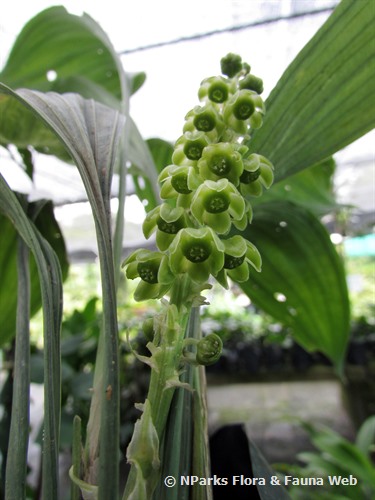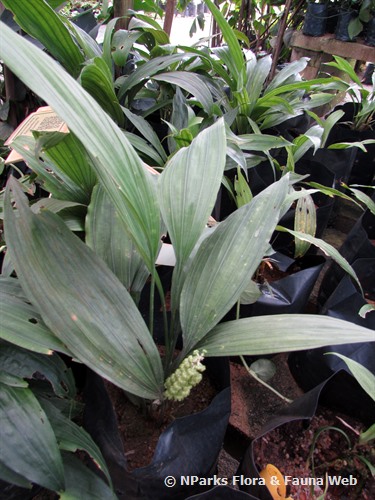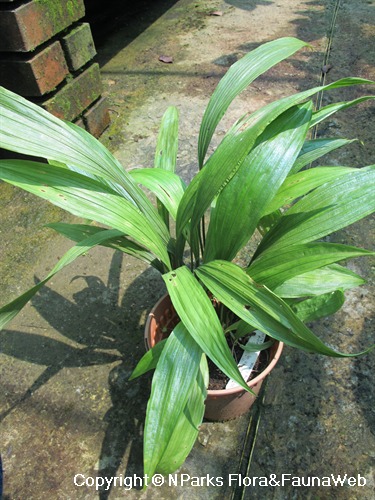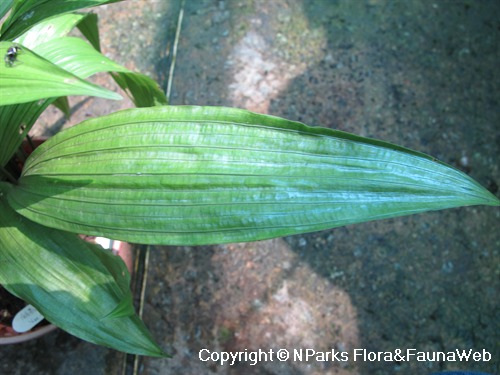
Back
Peliosanthes teta subsp. humilis (Andrews) Jessop ex Gandhi
| Family Name: | Asparagaceae |
| Synonyms: | Peliosanthes humilis Andrews, Teta humilis (Andrews) Voigt, Peliosanthes albida Bak., Peliosanthes bakeri Hook.f., Peliosanthes lurida Ridl, Peliosanthes parviflora Ridl., Peliosanthes serrulata L.Rodr., Peliosanthes viridis Ridl., Ophiopogon gracilipes Craib, |
| Common Name: | Derhaka Mertua, Bujang Hilir, Akar Ratus, Akar Suntong, Galak Tua, Tadah Embun, Serenget |
Peliosanthes teta subsp. humilis is a perennial herbaceous plant that can be locally found in the shaded forest floor of Singapore. It produces pleated, green, elliptic to egg-shaped leaves and an long inflorescence of fleshy, green to purple flowers.
Name
Classifications and Characteristics
| Plant Division | Angiosperms (Flowering Seed Plants) (Monocotyledon) |
|---|---|
| Plant Growth Form | Herbaceous Plant |
| Lifespan (in Singapore) | Perennial |
| Mode of Nutrition | Autotrophic |
Biogeography
| Native Distribution | India, Bangladesh, East Himalaya, Myanmar, Laos, Cambodia, Vietnam, Thailand, Malaysia, Singapore, Borneo, Sumatra, Java, Lesser Sunda Islands |
|---|---|
| Native Habitat | Terrestrial (Primary Rainforest) |
| Preferred Climate Zone | Tropical |
| Local Conservation Status | Native to Singapore (Endangered (EN)) |
Description and Ethnobotany
| Growth Form | It is a perennial herbaceous plant that reaches up to 80 cm tall. |
|---|---|
| Foliage | The leaves are green, almost linear or elliptic to ovate or obovate, measuring up to 12.5 - 37.5 cm long × 1.5 - 8.5 cm wide. Pleats are visible throughout the length of the leaves. The petioles (leaf stalks) are 7.5 - 45 cm long and slightly compressed. Scale leaves are present on some nodes of the rhizomes (thick, horizontal modified stems). |
| Stems | It has a stout underground rhizome (thick, horizontal modified stem), usually less than 5 cm in length. |
| Flowers | The inflorescence is an unbranched raceme, measuring up to 20 cm long. The peduncle (central stalk on the inflorescence) is flattened at the base and can be up to 35 cm long. Individual flowers are sometimes green but often white, violet or purple, usually subtended by oval-shaped bracts. Flowers are made up of tepals (indistinguishable petals and sepals that resemble one another), fused stamens forming a disc and a pistil. |
| Fruit | The fruit is an ellipsoid berry that matures from green to blue. The blue seeds are numerous, each up to 10 - 12 mm long. |
| Habitat | It can be found in wet evergreen forests, preferring shady habitats, and is sometimes found on rocks and often near running water, at elevations ranging from 0 to 1600 m above sea level. |
| Taxonomy | This subsp. humilis is identified by the solitary flower borne in the axils of the bracts, compared to the 2 - 6 flowers per axil in subsp. teta. |
| Cultivation | It grows best in partial shade and prefers well-draining, loamy soil. It can be propagated by division and seeds. |
| Etymology | The genus Peliosanthes is derived from the Greek terms, pelios "dark" or "purple", and anthos "flower", referring to the dark-coloured flowers found within the genus. The specific epithet teta is from the Indian vernacular name of this species. |
Landscaping Features
| Desirable Plant Features | Ornamental Flowers |
|---|---|
| Landscape Uses | Parks & Gardens, Small Gardens, Interiorscape/ Indoor Plant, Container Planting |
| Thematic Landscaping | Naturalistic Garden |
Plant Care and Propagation
| Light Preference | Semi-Shade |
|---|---|
| Water Preference | Moderate Water |
| Plant Growth Rate | Moderate |
| Rootzone Tolerance | Well-Drained Soils, Fertile Loamy Soils |
| Propagation Method | Division, Seed |
Foliar
| Foliage Retention | Evergreen |
|---|---|
| Mature Foliage Colour(s) | Green |
| Mature Foliage Texture(s) | Raised / Sunken Veins, Thin |
| Foliar Modification | Flower/Fruit Bract, Scale-like |
| Foliar Type | Simple / Unifoliate |
| Foliar Arrangement Along Stem | Alternate |
| Foliar Attachment to Stem | Petiolate |
| Foliar Shape(s) | Non-Palm Foliage (Linear, Elliptical, Ovate, Obovate) |
| Foliar Venation | Parallel |
| Foliar Margin | Entire |
| Leaf Area Index (LAI) for Green Plot Ratio | 3.5 (Shrub & Groundcover - Monocot) |
Non - Foliar and Storage
| Root Type | Underground (Fibrous Root) |
|---|---|
| Specialised Storage Organ(s) | Underground (Rhizome) |
Floral (Angiosperm)
| Flower & Plant Sexuality | Bisexual Flowers |
| Flower Colour(s) | Green, Purple, White |
|---|---|
| Flower Grouping | Cluster / Inflorescence |
| Flower Location | Axillary |
| Flower Symmetry | Radial |
| Inflorescence Type | Raceme |
| Ovary Position | Semi-Inferior / Perigynous |
| Flowering Habit | Polycarpic |
Fruit, Seed and Spore
| Mature Fruit Colour(s) | Blue |
|---|---|
| Fruit Classification | Simple Fruit |
| Fruit Type | Fleshy Fruit , Berry |
| Mature Seed Colour(s) | Black, Blue |
| Seed Description | Up to 10 - 12 mm long. |
| Seed Quantity Per Fruit | Several (11-20) |
References
| References | Jessop, J.P. (1976). A Revision of Peliosanthes (Liliaceae). BLUMEA 23. 141 - 159. |
|---|
Image Repository
Others
| Master ID | 30799 |
|---|---|
| Species ID | 5154 |
| Flora Disclaimer | The information in this website has been compiled from reliable sources, such as reference works on medicinal plants. It is not a substitute for medical advice or treatment and NParks does not purport to provide any medical advice. Readers should always consult his/her physician before using or consuming a plant for medicinal purposes. |




